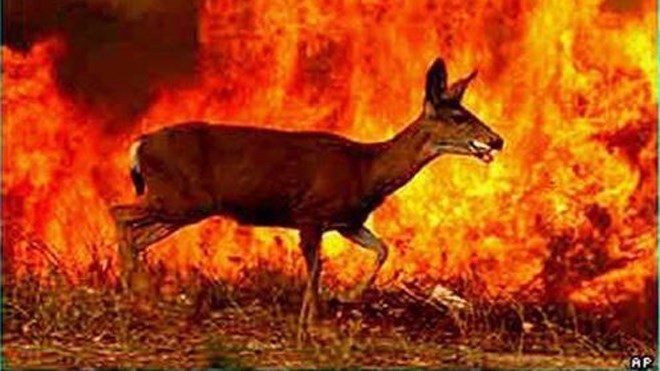Biology professor Josef Hamr lives on the French River, 10 kilometres from where the Parry Sound 33 forest fire has been burning since July 19.
At present, the blaze measures some 5,600 hectares in size and is not yet under control.
Hamr is an adjunct professor in the department of biology at Laurentian University. His research focuses on large wildlife, particularly restoration of the elk population in the Sudbury area, including south of Sudbury in Burwash right down to Georgian Bay. He has also worked with bears and wolves.
While the area he has researched has witnessed smaller fires, he has seen nothing like what has been seen in the Key River and French River areas this summer. Those smaller fires can be brought fairly quickly under control. Parry Sound 33 has been an exception in terms of size and of duration.
The MNR has brought in 535 support staff and firefighters from Minnesota, Wisconsin and Mexico to help fight the blazes.
Forest fires and wildlife
Fires are not a new thing. The forests and the creatures that call them home have evolved in this environment. Hamr said that animals have adapted their response to fire and their behaviour is quite predictable.
"Fires are part of nature. They've always been around and animals have learned how to adapt to fires," Hamr said. "If there's an immediate danger, the larger animals will run or amphibians and reptiles will go in the water and wait it out there.
"Many of the animals can get away from fire or survive fire if it doesn't last for a very long period of time. Some do get killed, there's no question about that, especially small animals and reptiles and amphibians."
Mice, salamanders, frogs, turtles and snakes are some of the small animals located in the area that Hamr has studied and where fires are currently burning. All Ontario turtles are listed at some level of risk: some threatened, and some endangered.
Which animals are at risk?
Hamr said that usually it's the small animals that suffer more from fires because they can't run as far or as fast as the large animals.
Turtles should be alright, he said, given they will typically go to water sources and wait until fires cease. Hamr predicts fires may have an impact on the Massassauga Rattler, which does live in part of the area of the fires around Georgian Bay, and is listed as threatened. Presently, he said it's hard to tell what impact fires will have on the population of rattlers.
Of the species at risk in Ontario, the following amphibians and reptiles live in the area impacted by this summer's northeastern forest fires: the eastern foxsnake (threatened in Georgian Bay area, endangered in Carolinian forests); Eastern hog-nosed snake (threatened); wood turtle (endangered); northern map turtle (special concern); and spotted turtle (endangered).
Fleeing animals
A popular Facebook post suggests animals fleeing fires might end up in people's backyards, and suggests being prepared for that by, for instance, leaving out water for those frightening woodland creatures to drink.
Hamr said it's certainly possible fleeing animals could end up in backyards in the area, and it doesn't hurt to put out water, but generally animals are well-equipped to take care of their needs, even in the midst of a fire.
"If you are in the immediate area of advancing fires you may see fleeing animals, but generally, I'm talking to people ... that live around here all the time and no one has seen any animals running from the fire," Hamr said. "As far as putting out water (as the post suggests), there is so much water in this area; there are ponds and there are marshes and rivers and lakes. I think that they will go to natural sources of water, rather than drinking out of a bucket. Especially a wild animal that has had no contact with people at all."
Generally, Hamr is not alarmed by the potential impact fires will have on animals in the region. He acknowledges that some small animals will die in a fire including squirrels, social hares, and small predators like the marten and fisher.
"Overall, even though it impacts individuals and it will kill some individuals, it does not really impact the populations of these animals because there are lots of them elsewhere where there are no burns."
What's happening now cannot compare to fires of the distant past either, before technology and combined resources became so capable of addressing forest fires.
"If you look at the past, before people started controlling fire, we probably had a much larger impact of fires over the whole boreal forest in this area here. There was no fire suppression," Hamr said in an interview. "Historical fires probably had much more impact than these fires here."
